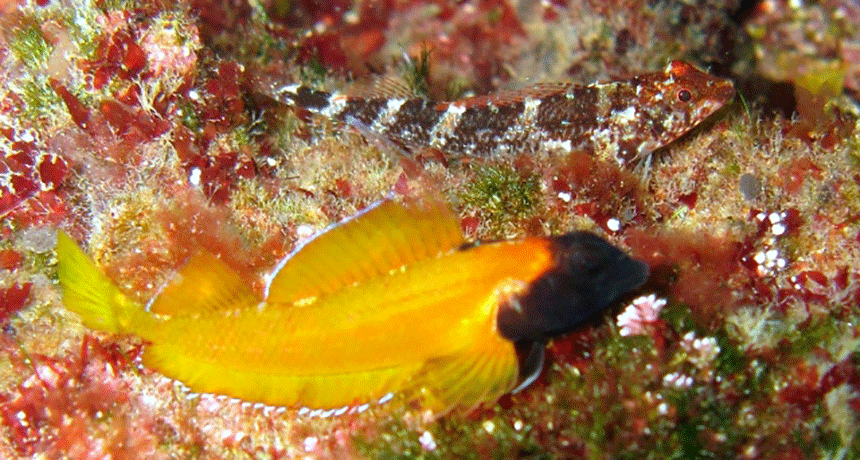These fish have truly flashing eyes
Light reflecting off bulging fish eyes makes colored sparks

The yellow-and-black fish in this picture is a male black-faced blenny. The striped fish behind him is a female. The eyes of these fish can emit tiny flashes of light.
Roberto Pillon/Wikimedia Commons (CC BY 3.0)
Some fish really have a twinkle in their eyes. A small reef fish can aim light through its bulging eyes and onto a reflective surface to send a blue or red flash into the water. The fish make more flashes when their favorite prey are present. These glimmers, which scientists call optical sparks, might therefore help the fish keep an eye on their potential meal.
At the University of Tübingen in Germany, Nico Michiels studies how fish use light. He noticed that a fish called the black-faced blenny (Tripterygion delaisi) has a particular glow to its eye. These fish live in shallow waters in the Mediterranean Sea and Atlantic Ocean. They like hanging out in crevices, then launching themselves at the tiny crustaceans they eat.
In the process, their eyes sparkle (see video below). “It really attracts your attention,” Michiels says. “It’s like there’s something glittery on the [eyes’] surface.”
Making eerie eye sparks
How do these fish make their eyes flash? In the black-faced blenny, “the lens of the eye sticks out…to quite a large extent,” Michiels says. “It’s like a bowl on the eye.” As light filters down into the water, it hits this bulging lens. That lens focuses the light coming into it. Light that passes through the lens and into the retina lets the fish see.
But in black-faced blennies, the lens doesn’t focus all the light onto the retina. It aims some light below the retina, onto the iris. This is the colored part of the eye. There, light bounces off of a reflective spot and back out into the water. The result is a tiny spark that seems to come out of the fish’s eye.
“It’s not a strong reflection,” Michiels says. He notes it’s about as bright as the light you’d see reflecting off a piece of white paper in a dark room.
But it’s not white light. Instead, the black-faced blenny can make twinkles in blue or red. “The blue is very specific,” Michiels says. The fish have a tiny blue spot on the lower part of their eye. If the light gets focused on that spot, the eye flashes a blue spark. Red sparks, on the other hand, are less specific. The blenny’s iris is slightly red. Light focused anywhere on the iris will produce a reddish spark.
Hunting by flashlight
At first, Michiels thought the blenny’s glimmers might be just a weird quirk of how their eyes work. Then he began to wonder if the fish could control their flashing — using it as, well, a type of flashlight.
To find out, he and his colleagues placed black-faced blennies against red and blue backgrounds. When they swam in a tank with a red background, the fish made blue sparks. With a blue background, they tended to make red sparks. “The fish are able to control what they do with their eyes and how often they produce [the spark],” Michiels reports.
The fish also made more flashes when facing live copepods (COH-puh-pahds). These are tiny crustaceans they like to eat. Michiels says this could mean that the blennies use eye sparks to shine extra light on potential prey. “They are ambush hunters like a cat,” Michiels says. “If they see something moving, they can’t stop the urge to try and get it.”
Michiels’ team wants to find out whether other fish have similarly flashy skills. “Anytime you go to an aquarium, you’ll see a large proportion of the fish will have ocular sparks,” he says. “Once you see what’s going on you start seeing it very well and wondering why no one noticed [it] before.” Michiels’ group published its results February 21 in the journal Royal Society Open Science.
More work needed
“It was an interesting paper,” says biologist Jennifer Gumm. She studies fish at Stephen F. Austin State University in Nacogdoches, Texas. The light is pretty weak, however — maybe too weak, she says, to help the fish get a meal. That flashing, she says, “is a byproduct of how the fish are moving their eyes.” She thinks more studies are needed to figure out if the fish emit flashes from their eyes on purpose to spot prey.
The sparks could be just a side effect of where the fish are gazing. After all, fish in the lab usually dine on dead, frozen copepods — a menu item that doesn’t move. So the fish could just be following the bouncing copepods with their eyes, not necessarily hunting them. Eye sparks might just be a sign of their rapt attention. But, Gumm adds, “I don’t think you’d find the same patterns if [the flashing] wasn’t relevant in some way,”
The sparks show off a neat new fishy talent, says David Gruber. He is a marine biologist at Harvard University in Cambridge, Mass. But he agrees with Gumm that scientists will need to do many more studies of how the fish behave to learn if they are deliberately using the eye flashes for some purpose. “It’s one thing to observe [the sparks], and another to prove they’re being used,” he explains.
The biggest problem of all? “You can’t talk to the fish,” Gruber says. Well, you can ask. They just won’t answer.







